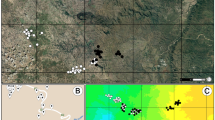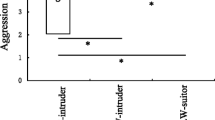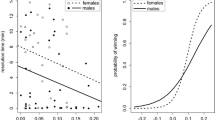Abstract
We investigated how morphological traits of territorial males in the polygynous bat Saccopteryx bilineata were related to their reproductive success. Because of the frequency of aerial courtship displays and defence manoeuvres, and the high energetic costs of flight, we expected small and symmetric males to be better able to court females on the wing and to monopolize copulations with females in their harems. We predicted that small and symmetric males would sire more offspring within the colony and a larger portion of the young born within their harem than large or asymmetric males. We measured size and fluctuating asymmetry of 21 territorial males and analysed their reproductive success in 6 offspring cohorts (n=209 juveniles) using 11 microsatellite loci. As predicted, small and symmetric males had, on average, a higher reproductive success in the colony than large and asymmetric males. The percentage of young sired by males within their harem increased as males decreased in size, but was not influenced by fluctuating asymmetry. As fluctuating asymmetry of males correlated with their reproductive success within the colony but not within their harems, we infer that fluctuating asymmetry is probably related to female choice, whereas male size is probably important for harem defence on the wing.



Similar content being viewed by others
References
Anderson SS, Fedak MA (1985) Grey seal males: energetic and behavioural links between size and sexual success. Anim Behav 33:928–838
Andersson M (1994) Sexual selection. Princeton University Press, Princeton
Backhaus K, Erichson B, Plinke W, Weiber R (1996) Multivariate Analysemethoden. Springer, Berlin Heidelberg New York
Behr O, Helversen O von (2004) Bat serenades—complex courtship songs of the sac-winged bat (Saccopteryx bilineata). Behav Ecol Sociobiol 56:106–115
Bradbury JW, Emmons L (1974) Social organization of some Trinidad bats. I. Emballonuridae. Z Tierpsychol 36:137–183
Bradbury JW, Vehrencamp SL (1976) Social organization and foraging in Emballonurid bats. I. Field studies. Behav Ecol Sociobiol 1:337–381
Bradbury JW, Vehrencamp SL (1977) Social organization and foraging in Emballonurid bats. III. Mating systems. Behav Ecol Sociobiol 2:1–17
Davidson SM, Wilkinson GS (2002) Geographic and individual variation in vocalizations by male Saccopteryx bilineata (Chiroptera: Emballonuridae). J Mammal 83:526–535
Davidson SM, Wilkinson GS (2004) Function of male song in the greater white-lined bat, Saccopteryx bilineata. Anim Behav 67:883–891
Elashoff JD (1995): nQuery Adviser Version 4.0
Hakkarainen H, Huhta E, Lathi K, Lundvall P, Mappes T, Tolonen P, Wiehn J (1996) A test of male mating and hunting success in the kestrel: the advantages of smallness. Behav Ecol Sociobiol 39:375–380
Heckel G, Helversen O von (2002) Male tactics and reproductive success in the harem polygynous bat Saccopteryx bilineata. Behav Ecol 13:750–756
Heckel G, Helversen O von (2003) Genetic mating system, relatedness and the significance of harem associations in the bat Saccopteryx bilineata. Mol Ecol 12:219–227
Heckel G, Voigt CC, Mayer F, Helversen O von (1999) Extra-harem paternity in the white-lined bat Saccopteryx bilineata. Behaviour 136:1173–1185
Heckel G, Achmann R, Mayer F (2000) Highly polymorphic microsatellite markers in the white-lined bat (Saccopteryx bilineata). Mol Ecol 9:242–244
Kleiber M (1966) The fire of life. Wiley, New York
Kruuk LEB, Slate J, Pemberton JM, Clutton-Brock TH (2003) Fluctuating asymmetry in a secondary sexual trait: no associations with individual fitness, environmental stress or inbreeding, and no heritability. J Evol Biol 16:101–113
Marshall TC, Slate J, Kruuk LEB, Pemberton JM (1998) Statistical confidence for likelihood-based paternity inference in natural populations. Mol Ecol 7:639–655
Møller AP (1980) Fluctuating asymmetry in male sexual ornaments may reliably reveal male quality. Anim Behav 40:1185–1187
Møller AP, Swaddle JP (1997) Asymmetry, developmental stability, and evolution. Oxford University Press, Oxford
Norberg UM (1995) How a long tail and changes in mass and wing shape affect the cost for flight in animals. Funct Ecol 9:48–54
Norberg UM, Rayner JMV (1987) Ecological morphology and flight in bats (Mammalia; Chiroptera): wing adaptations, flight performance, foraging strategy and echolocation. Philos Trans R Soc Lond B 316:335–427
Petrie M (1983) Female moorhens compete for small fat males. Science 220:413–414
Rose KE, Clutton-Brock TH, Guinness FE (1998) Cohort variation in male survival and lifetime breeding success in red deer. J Anim Ecol 67:979
Say L, Naulty F, Hayden TJ (2003) Genetic and behavioural estimates of reproductive skew in male fallow deer. Mol Ecol 12:2793
Schulte-Hostedde A, Millar JS, Gibbs HL (2003) Female-biased sexual size dimorphism in the yellow-pine chipmunk (Tamias amoenus): sex-specific patterns of annual reproductive success and survival. Evolution 56:2519–2529
Shuster SM, Wade MJ (2003) Mating systems and strategies. Princeton University Press, Princeton
SPSS (1994) SPSS Trends 6.1. SPSS
Stockwell EF (2001) Morphology and flight manoeuvrability in New World leaf-nosed bats (Chiroptera: Phyllostomidae). J Zool 254:505–514
Swaddle JP (1997) Within-individual changes in developmental stability affect flight performance. Behav Ecol 8:601
Swaddle JP, Witter MS, Cuthill IC (1994) The analysis of fluctuating asymmetry. Anim Behav 48:986–989
Swaddle JP, Witter MS, Cuthill IC, Budden A, McCowen P (1996) Plumage condition affects flight performance in common starlings: implications for developmental homeostasis, abrasion and moult. J Avian Biol 27:103–111
Tannenbaum R (1975) Reproductive strategies in the white-lined Bat. PhD Thesis, Cornell University
Thomas ALR (1993) The aerodynamic costs of asymmetry in the wings and tail of birds: asymmetric birds can’t fly round tight corners. Proc R Soc Lond B 254:181–189
Voigt CC (2000) Intraspecific scaling of flight costs in the bat Glossophaga soricina (Phyllostomidae). J Comp Physiol B 170:403–410
Voigt CC, Helversen O von (1999) Storage and display of odor by male Saccopteryx bilineata (Chiroptera; Emballonuridae). Behav Ecol Sociobiol 47:29–40
Voigt CC, Streich WJ (2003) Queuing for harem access in colonies of the sac-winged bat. Anim Behav 65:149–156
Voigt CC, Winter Y (1999) The energetic costs of hovering flight in nectar-feeding bats (Phyllostomidae, Glossophaginae) and its scaling in sphingid moths, hummingbirds and bats. J Comp Physiol B 169:38–48
Voigt CC, Helversen O von, Michener RH, Kunz TH (2001) The economics of harem maintenance in the sac-winged bat Saccopteryx bilineata. Behav Ecol Sociobiol 50:31–36
Voigt CC, Heckel G, Helversen O von (2003) Conflicts and strategies in the harem-polygynous mating system of the sac-winged bat Saccopteryx bilineata. In: McCracken G, Zubaid A, Kunz TH (eds) Functional and evolutionary ecology of bats, Oxford University Press, Oxford
Witter MS, Cuthill IC, Bonser RHC (1994) Experimental investigations of mass-dependent predation risk in the European starling, Sturnus vulgaris. Anim Behav 48:201–222
Worthington-Wilmer J, Barrat E (1996) A non-lethal method of tissue sampling for genetic studies of chiropterans. Bat Res News 37:1–3
Worthington-Wilmer J, Overall AJ, Pomeroy PP, Twis SD, Amos W (2000) Patterns of paternal relatedness in British grey seal colonies. Mol Ecol 9:283–292
Acknowledgements
We wish to express our thanks to Martina Brandt, Anne Brunner, Sonja Meister, Oliver Behr, Otto von Helversen, Marion East, and Heribert Hofer. We also thank the Costa Rican authorities for permission to conduct research in Costa Rica, and the Organization for Tropical Studies for permission to work on their property. Financial support was provided by the Deutsche Forschungsgemeinschaft (DFG Vo 890/3).
Author information
Authors and Affiliations
Corresponding author
Additional information
Communicated by G. Wilkinson
Rights and permissions
About this article
Cite this article
Voigt, C.C., Heckel, G. & Mayer, F. Sexual selection favours small and symmetric males in the polygynous greater sac-winged bat Saccopteryx bilineata (Emballonuridae, Chiroptera). Behav Ecol Sociobiol 57, 457–464 (2005). https://doi.org/10.1007/s00265-004-0874-6
Received:
Revised:
Accepted:
Published:
Issue Date:
DOI: https://doi.org/10.1007/s00265-004-0874-6




